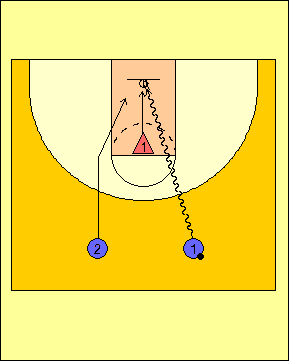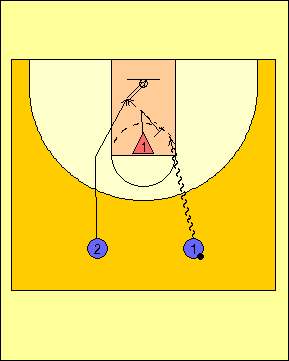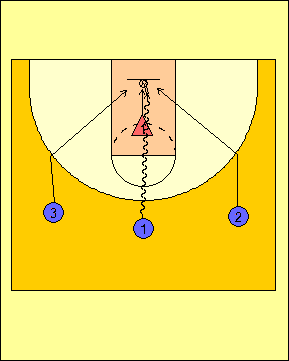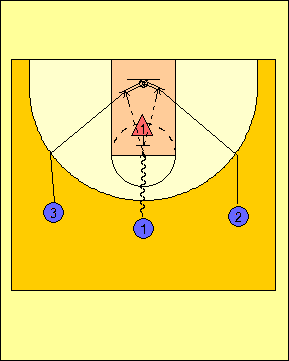|

Basketball Coaching DVD's at Championship Productions
FAST BREAK OFFENSE
In the modern game of basketball, virtually every team on the high school,
college and professional levels runs some sort of fast break offense that is
designed to increase scoring, take advantage of turnovers and missed shots,
Advantages of the Fast Break Offense
In running the fast break offense, there are several advantages that give a
coach the rationale to run this type of offense. They include, but are not
limited to:
-
It is the best offense to take advantage of
quick, athletic players. Basketball is a game based on the
team with the best quick players. The most successful teams
are typically those who can play at a quick pace and who can get
their players up and down the floor faster than the other team.
-
The offense typically results in high-percentage
shots. The fast break offense usually leads to lay-ups and
unguarded three-point jumpers. When running the fast break
offense, you will find that your players are most successful when
they are able to get high-percentage shots and at a high volume.
Teams that run the fast break can be among the best in field goal
percentage offense and scoring offense per game.
-
It encourages your players to play harder on
defense. When you give your players the incentive to play hard
on defense by rewarding them with fast break opportunities, they
will respond. The best opportunities are on steals that are
caused by defensive pressure which results from players playing hard
on defense.
Disadvantages of the Fast Break Offense
However, there are disadvantages to running a fast break offense which include
the following:
-
The fast break requires a large amount of
practice time. If you are going to be a good running team,
you have to commit to it all the way or you will fail.
Sometimes, you will need at least 40 minutes per practice to perfect
your fast break offense. This is needed to make all of the
necessary corrections and to have your team ready to play at a fast
tempo every time you play.
-
Your players must be proficient in playing at a
fast tempo. If you have players who get sloppy with the
basketball playing at a normal pace, you should probably consider
not running. Turnovers and missed shots happen more frequently
when you play at a faster pace. If you already have problems
with relatively sloppy play on offense in the half court, the fast
break will most likely not be something that would work well for
your team.
-
The coach has to give up some level of control
over his/her basketball team. Coaches, if you have a
problem giving your players a degree of control over how they play
the game, you should probably not run. Players are going to
make bad decisions, but they have the tendency to make more bad
decisions if you entertain the idea of a running game. If you
believe that your having more control over the team means more
success, it would be best not to fast break.
Despite all of these disadvantages, a number of my teams
have had great success in running the fast break and I encourage coaches
at all levels to work on situations where you can take advantage of easy
shots and work at getting more of those easy shots than your opponents.
Primary Break
In running the primary break, we want to run it in situations where we have two
or fewer defenders and a numbers advantage. In every instance, we want to
attack the basket and get a lay-up. We also want to take advantage of
possible defensive breakdowns.
When we attack in a two-on-one situation, we want to get the ball in the hands
of our best ballhandler and have him attack the basket. If the defender
decides to retreat, we want the ballhandler to go in for the lay-up (Diagram 1).
If the defensive player decides to stop the dribble drive of our best
ballhandler, we want the ballhandler to pass the ball to the other player
running the fast break. That player will then shoot the lay-up (Diagram
2).

Diagram 1 |

Diagram 2 |
In running our three-on-one break, we want to make the defensive player guard
against three possible shooters. Again, our goal is lay-ups so all three
players will attempt to shoot lay-ups if they get the basketball.
The read is made by the point guard as to what the defensive player does.
If the defender retreats, we want the point guard to attack the basket (Diagram
3). If the defender decides to engage the point guard, he has two pass
options and whoever gets the ball will shoot the lay-up (Diagram 4).

Diagram 3 |

Diagram 4 |
Read the full article and many others by signing up for a Coach Peel
Basketball membership today.
Membership Subscription with Monthly Payments: $6.00 per
month
Membership Subscription with Quarterly Payments:
$15.00 per quarter (save over 16.6%)
Membership Subscription with Annual Payments: $50.00 per
year (save over 30.5% & get your first 30 days free!)

© 2010-2017 Alan Peel Enterprises
|